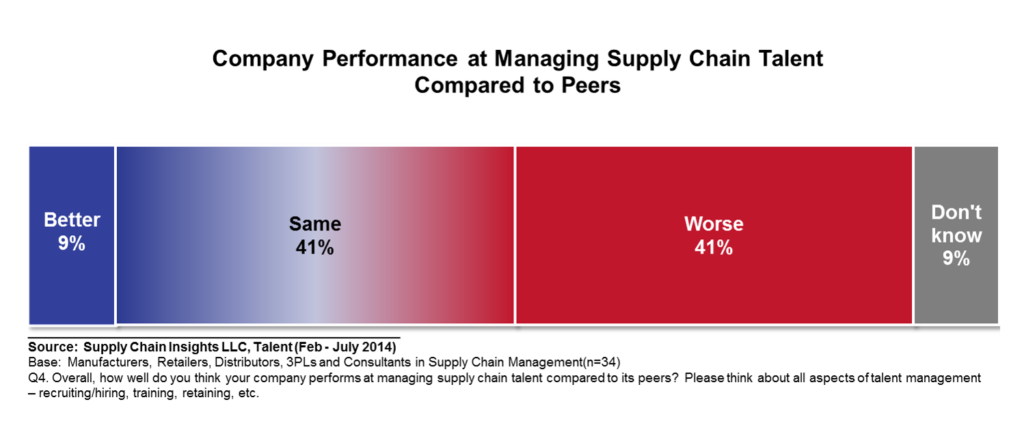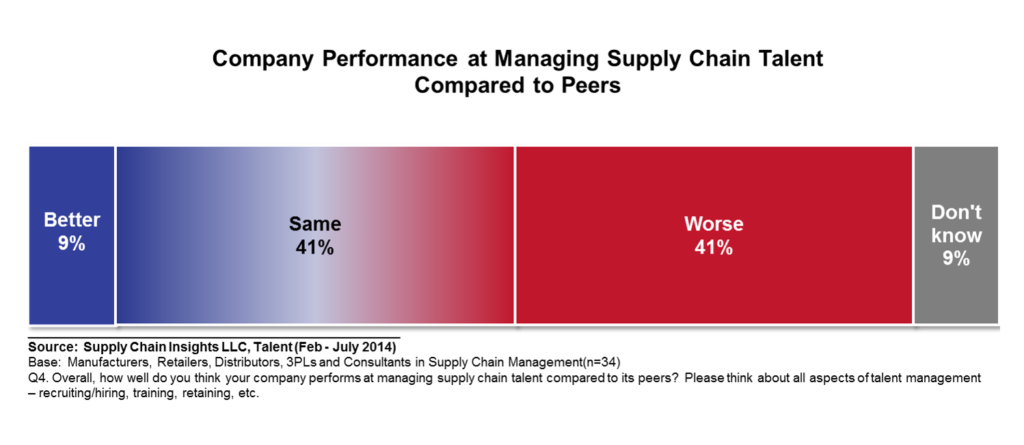These are the grim facts. Only 9% of companies feel that they manage supply chain talent better than their peers. The issues are growing. Job turnover is 15% and new positions remain open for 4 months before they are filled. I think that supply chain talent is a broken link in the supply chain. I also believe that the adoption of new mental models is a barrier to progress.

On August 5th, I will be hosting a webinar on supply chain talent. I will be joined by Keith Holliday of Sunoco Products and Jacqueline Faseler of Dow Chemical to discuss the research results of a talent survey that we are completing. The survey is still open and the final results will be shared at our upcoming Supply Chain Insights Global Summit on September 10th-11th.
During the webinar, I look forward to dialogue with the panel on the research findings on these charts. I find it interesting, in the research, that supply chain talent is seen as an increasing point of pain and that the adoption of new ways of thinking is a barrier to closing the gap. I want to know more about why the panel thinks this is the case.

A Case Study
I welcome their perspective on how to solve the problem. Let me explain through a story. Last week I was on a call with a client that was looking for a consulting partner to help redesign demand planning processes. This new contact had previously been a CFO at the same firm and was new to supply chain. Early in the conversation, the client admitted that they did not know much about supply chain. The organization had implemented a good demand planning technology, but badly, ten years ago. In this initial implementation, they made the mistake of automating their old processes with new technology; and due to other project commitments, the organization has not upgraded the technology and rectified the situation.
The conversation went like this, “I want to implement best-in-class demand processes. I don’t have time to look at the technology, and I want to hire someone with gray hair that has done it well at another company to come and help me.”
I scratched my head. My struggle was three-fold:
- The demand planners at this organization are quite good. I have worked with them for many years. It is my belief that they would give this CFO better advice than 9 out of 10 consultants that I would shortlist into this account. They have been looking for management support to fix a bad situation for a decade, but to no avail. Based on the conversation, I don’t believe they’ll have a voice in the outcome.
- The initial implementation was flawed because the company automated their past practices and did not understand what was possible through technology automation. It is happening again. At the time of the first implementation, they were using spreadsheets, and they implemented the new technology based on spreadsheet-like thinking, and never used the optimizers. Using this approach, when will the company ever be able to look at what the processes could be through the advancements in technology? The client expressed the new goal as a “redesign of the demand planning processes with no discussion of technology.” This well-intended CFO is making no attempt to understand what is possible through the software. My struggle is that I find it almost impossible to design demand planning processes without including a discussion of the technology’s capabilities. Why? The technologies, and potential outcomes, are so different by system; and I find most executives that are not familiar with planning woefully lacking an understanding of what a good demand planning implementation could be. Demand planning cannot be done well on a spreadsheet.
- As we talked, it was clear to me that this prior CFO was more comfortable with a gray-hair approach. The request was for someone who is seasoned and had implemented demand planning processes before. My issue is that these processes are in a massive overhaul in the industry, and that someone who has implemented one or two times will only understand this more limited perspective, not what is possible. The CFO was unwilling to engage with the technology provider resources (whose resources are quite good) to understand what is possible, and they did not want to tap the resources of more seasoned consultants that had a broader perspective. It is my hope that the person she finally selects to help reads my research, and will bring these insights into the account:
- Consensus Forecasting Sounds Good, But Has Been Problematic. Consensus forecasting processes implemented in the beginning of the last decade to include sales and marketing input sound good, but introduce bias into the forecast. The average bias can increase 5-9% through consensus forecasting if the organization does not adopt Forecast Value-Add techniques.
- Demand Planning Needs to Report to a Neutral Party. When demand planning reports to a sales or marketing function, the forecasts tend to have higher error and bias. It needs to report to a central planning group or a center of excellence. The focus needs to be on the reduction of bias and error.
- Use the Technology. I can count the number of successful demand planning implementations on my two hands. There are not a lot of great demand organizations: most have organized for supply. However, when the technologies are properly implemented, and the forecast is used in decision-making processes, it matters. I can see it in the results that I will present in Scottsdale. This is one case in supply chain thinking where I think the understanding of what the technologies can do is paramount to making improvement. However, executives do not trust software vendors; and based on the dynamics of the software vendors in the market, I understand why. This continues to be a dilemma.
So, let’s apply the lessons from this story to the talent discussion. The story demonstrates two gaps that I see often that tie to the talent discussion we will be having next Tuesday.
The first gap is the senior leadership’s understanding of supply chain. When senior leadership is assigned to manage the supply chain without training or prior experience, there is a lack of understanding of what is possible. While financial processes are transactional in nature and can be managed in spreadsheets, the supply chain decision-making processes are forward-looking flows requiring technology and optimization. Staying current on industry practices matters to performance. A new leader has to quickly sort out who they can trust in their organization and build a guiding coalition.
The second gap is the management of talent. How do these demand planners get a voice to drive adoption of an automated process that could work?
At the end of the call, I short-listed some consultants I thought could help, but I think that the dialogue represents the essence of the problem we will be talking about on Tuesday in the webinar; and on September 10th and 11th at the Supply Chain Global Summit in Scottsdale, AZ. In short, senior leaders and directors need to reskill. Supply chain processes and technologies are changing and can drive improved outcomes. It shouldn’t be about yesteryear’s processes and technologies with limited thinking. Instead, we need to unleash the power of the supply chain team to scale new heights. It starts with talent. For me, this is exciting; and, I believe that our mental models are at the crux of the talent issue. What do you think?
I hope to see you there!







